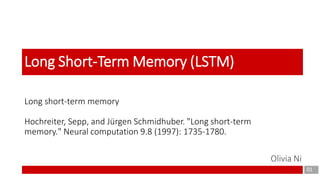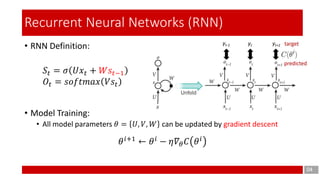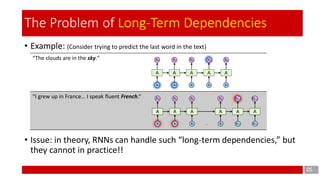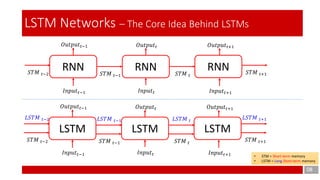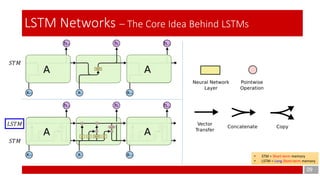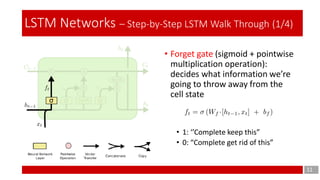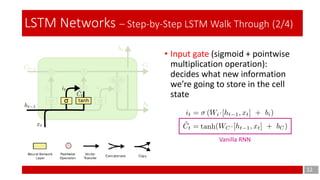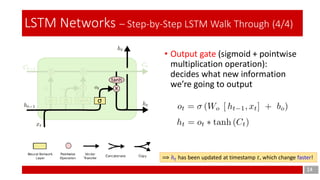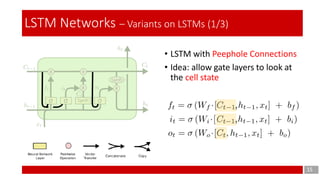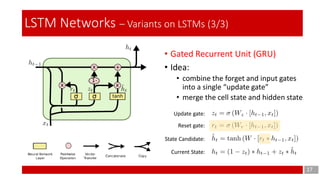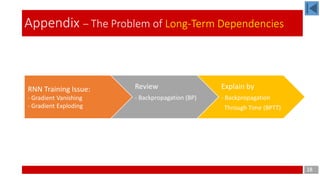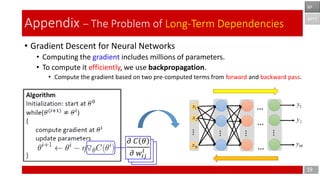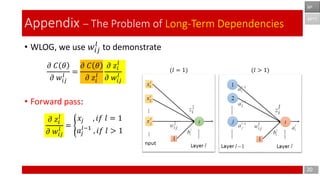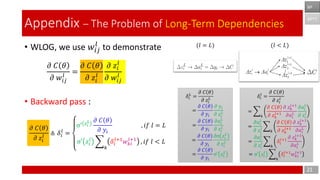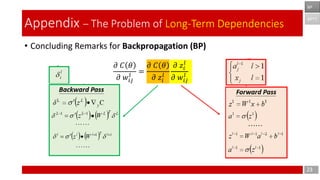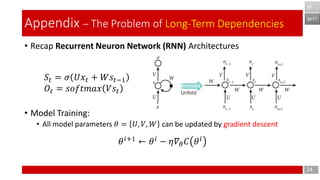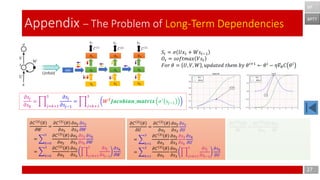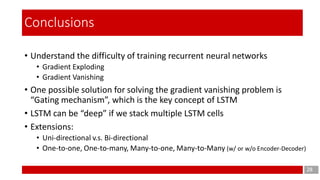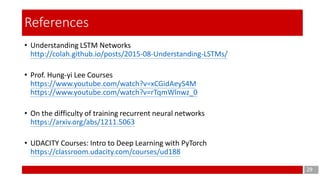LSTM
- 1. Long short-term memory Hochreiter, Sepp, and Jürgen Schmidhuber. "Long short-term memory." Neural computation 9.8 (1997): 1735-1780. 01 Long Short-Term Memory (LSTM) Olivia Ni
- 2. • Recurrent Neural Networks (RNN) • The Problem of Long-Term Dependencies • LSTM Networks • The Core Idea Behind LSTMs • Step-by-Step LSTM Walk Through • Variants on LSTMs • Conclusions & References • Appendix (BPTT Gradient Exploding/ Vanishing) 02 Outline
- 3. • Idea: • condition the neural network on all previous information and tie the weights at each time step • Assumption: temporal information matters (i.e. time series data) 03 Recurrent Neural Networks (RNN) RNN RNNRNN 𝐼𝑛𝑝𝑢𝑡 𝑡 𝑂𝑢𝑡𝑝𝑢𝑡 𝑡 𝑆𝑇𝑀 𝑡−1 𝑆𝑇𝑀 𝑡 𝐼𝑛𝑝𝑢𝑡 𝑡−1 𝑂𝑢𝑡𝑝𝑢𝑡 𝑡−1 𝐼𝑛𝑝𝑢𝑡 𝑡+1 𝑂𝑢𝑡𝑝𝑢𝑡 𝑡+1 𝑆𝑇𝑀 𝑡−2 𝑆𝑇𝑀 𝑡+1 • STM = Short-term memory
- 4. • RNN Definition: • Model Training: • All model parameters 𝜃 = 𝑈, 𝑉, 𝑊 can be updated by gradient descent 04 Recurrent Neural Networks (RNN) 𝑆𝑡 = 𝜎 𝑈𝑥𝑡 + 𝑊𝑠𝑡−1 𝑂𝑡 = 𝑠𝑜𝑓𝑡𝑚𝑎𝑥 𝑉𝑠𝑡 𝜃 𝑖+1 ← 𝜃 𝑖 − 𝜂𝛻𝜃 𝐶 𝜃 𝑖
- 5. • Example: (Consider trying to predict the last word in the text) • Issue: in theory, RNNs can handle such “long-term dependencies,” but they cannot in practice!! “The clouds are in the sky.” “I grew up in France… I speak fluent French.” 05 The Problem of Long-Term Dependencies
- 6. • RNN Training Issue: (1) The gradient is a product of Jacobian matrices, each associated with a step in the forward computation (2) Multiply the same matrix at each time step during BPTT • The gradient becomes very small or very large quickly • Vanishing or Exploding gradient • The error surface is either very flat or very steep 06 The Problem of Long-Term Dependencies
- 7. • Possible Solutions: • Gradient Exploding: • Clipping (https://arxiv.org/abs/1211.5063?context=cs) • Gradient Vanishing: • Better Initialization (https://arxiv.org/abs/1504.00941) • Gating Mechanism (LSTM, GRU, …, etc.) • Attention Mechanism (https://arxiv.org/pdf/1706.03762.pdf) 07 The Problem of Long-Term Dependencies
- 8. 08 LSTM Networks – The Core Idea Behind LSTMs RNN RNNRNN 𝐼𝑛𝑝𝑢𝑡 𝑡 𝑂𝑢𝑡𝑝𝑢𝑡 𝑡 𝑆𝑇𝑀 𝑡−1 𝑆𝑇𝑀 𝑡 𝐼𝑛𝑝𝑢𝑡 𝑡−1 𝑂𝑢𝑡𝑝𝑢𝑡 𝑡−1 𝐼𝑛𝑝𝑢𝑡 𝑡+1 𝑂𝑢𝑡𝑝𝑢𝑡 𝑡+1 𝑆𝑇𝑀 𝑡−2 𝑆𝑇𝑀 𝑡+1 • STM = Short-term memory • LSTM = Long Short-term memory LSTM LSTMLSTM 𝐼𝑛𝑝𝑢𝑡 𝑡 𝑂𝑢𝑡𝑝𝑢𝑡 𝑡 𝑆𝑇𝑀 𝑡−1 𝑆𝑇𝑀 𝑡 𝐼𝑛𝑝𝑢𝑡 𝑡−1 𝑂𝑢𝑡𝑝𝑢𝑡 𝑡−1 𝐼𝑛𝑝𝑢𝑡 𝑡+1 𝑂𝑢𝑡𝑝𝑢𝑡 𝑡+1 𝑆𝑇𝑀 𝑡−2 𝑆𝑇𝑀 𝑡+1 𝐿𝑆𝑇𝑀 𝑡−1 𝐿𝑆𝑇𝑀 𝑡 𝐿𝑆𝑇𝑀 𝑡−2 𝐿𝑆𝑇𝑀 𝑡+1
- 9. 09 LSTM Networks – The Core Idea Behind LSTMs • STM = Short-term memory • LSTM = Long Short-term memory 𝐿𝑆𝑇𝑀 𝑆𝑇𝑀 𝑆𝑇𝑀
- 10. 10 LSTM Networks – Step-by-Step LSTM Walk Through (0/4) • The cell state runs straight down the entire chain, with only some minor linear interactions. Easy for information to flow along it unchanged • The LSTM does have the ability to remove or add information to the cell state, carefully regulated by structures called gates.
- 11. 11 LSTM Networks – Step-by-Step LSTM Walk Through (1/4) • Forget gate (sigmoid + pointwise multiplication operation): decides what information we’re going to throw away from the cell state • 1: ‘’Complete keep this” • 0: “Complete get rid of this”
- 12. 12 LSTM Networks – Step-by-Step LSTM Walk Through (2/4) • Input gate (sigmoid + pointwise multiplication operation): decides what new information we’re going to store in the cell state Vanilla RNN
- 13. 13 LSTM Networks – Step-by-Step LSTM Walk Through (3/4) • Cell state update: forgets the things we decided to forget earlier and add the new candidate values, scaled by how much we decided to update • 𝑓𝑡: decide which to forget • 𝑖 𝑡: decide which to update ⟹ 𝐶𝑡 has been updated at timestamp 𝑡, which change slowly!
- 14. 14 LSTM Networks – Step-by-Step LSTM Walk Through (4/4) • Output gate (sigmoid + pointwise multiplication operation): decides what new information we’re going to output ⟹ ℎ 𝑡 has been updated at timestamp 𝑡, which change faster!
- 15. 15 LSTM Networks – Variants on LSTMs (1/3) • LSTM with Peephole Connections • Idea: allow gate layers to look at the cell state
- 16. 16 LSTM Networks – Variants on LSTMs (2/3) • LSTM with Coupled Forget/ Input Gate • Idea: we only forget when we’re going to input something in its place, and vice versa.
- 17. 17 LSTM Networks – Variants on LSTMs (3/3) • Gated Recurrent Unit (GRU) • Idea: • combine the forget and input gates into a single “update gate” • merge the cell state and hidden state Update gate: Reset gate: State Candidate: Current State:
- 18. Explain by - Backpropagation Through Time (BPTT) RNN Training Issue: - Gradient Vanishing - Gradient Exploding Review - Backpropagation (BP) 18 Appendix – The Problem of Long-Term Dependencies
- 19. 𝜕 𝐶 𝜃 𝜕 𝑤𝑖𝑗 𝑙 𝜕 𝐶 𝜃 𝜕 𝑤𝑖𝑗 𝑙 • Gradient Descent for Neural Networks • Computing the gradient includes millions of parameters. • To compute it efficiently, we use backpropagation. • Compute the gradient based on two pre-computed terms from forward and backward pass. 19 Appendix – The Problem of Long-Term Dependencies 𝜕 𝐶 𝜃 𝜕 𝑤𝑖𝑗 𝑙 BPTT BP
- 20. 𝜕 𝐶 𝜃 𝜕 𝑤𝑖𝑗 𝑙 = 𝜕 𝐶 𝜃 𝜕 𝑧𝑖 𝑙 𝜕 𝑧𝑖 𝑙 𝜕 𝑤𝑖𝑗 𝑙 • WLOG, we use 𝑤𝑖𝑗 𝑙 to demonstrate • Forward pass: 20 Appendix – The Problem of Long-Term Dependencies 𝜕 𝑧𝑖 𝑙 𝜕 𝑤𝑖𝑗 𝑙 = ൝ 𝑥𝑗 , 𝑖𝑓 𝑙 = 1 𝑎𝑗 𝑙−1 , 𝑖𝑓 𝑙 > 1 (𝑙 = 1) (𝑙 > 1) BPTT BP
- 21. 𝜕 𝐶 𝜃 𝜕 𝑤𝑖𝑗 𝑙 = 𝜕 𝐶 𝜃 𝜕 𝑧𝑖 𝑙 𝜕 𝑧𝑖 𝑙 𝜕 𝑤𝑖𝑗 𝑙 • WLOG, we use 𝑤𝑖𝑗 𝑙 to demonstrate • Backward pass : 21 Appendix – The Problem of Long-Term Dependencies (𝑙 = 𝐿) (𝑙 < 𝐿) 𝛿𝑖 𝐿 = 𝜕 𝐶 𝜃 𝜕 𝑧𝑖 𝐿 = 𝜕 𝐶 𝜃 𝜕 𝑦𝑖 𝜕 𝑦𝑖 𝜕 𝑧𝑖 𝐿 = 𝜕 𝐶 𝜃 𝜕 𝑦𝑖 𝜕𝑎𝑖 𝐿 𝜕 𝑧𝑖 𝐿 = 𝜕 𝐶 𝜃 𝜕 𝑦𝑖 𝜕σ 𝑧𝑖 𝐿 𝜕 𝑧𝑖 𝐿 = 𝜕 𝐶 𝜃 𝜕 𝑦𝑖 σ′ 𝑧𝑖 𝐿 BPTT BP 𝛿𝑖 𝑙 = 𝜕 𝐶 𝜃 𝜕 𝑧𝑖 𝑙 = 𝑘 𝜕 𝐶 𝜃 𝜕 𝑧 𝑘 𝑙+1 𝜕 𝑧 𝑘 𝑙+1 𝜕𝑎𝑖 𝐿 𝜕𝑎𝑖 𝐿 𝜕 𝑧𝑖 𝑙 = 𝜕𝑎𝑖 𝐿 𝜕 𝑧𝑖 𝑙 𝑘 𝜕 𝐶 𝜃 𝜕 𝑧 𝑘 𝑙+1 𝜕 𝑧 𝑘 𝑙+1 𝜕𝑎𝑖 𝐿 = 𝜕𝑎𝑖 𝐿 𝜕 𝑧𝑖 𝑙 𝑘 𝛿𝑖 𝑙+1 𝜕 𝑧 𝑘 𝑙+1 𝜕𝑎𝑖 𝐿 = σ′ 𝑧𝑖 𝑙 𝑘 𝛿𝑖 𝑙+1 𝑤 𝑘𝑖 𝑙+1 𝜕 𝐶 𝜃 𝜕 𝑧𝑖 𝑙 ≜ 𝛿𝑖 𝑙 = σ′ 𝑧𝑖 𝐿 𝜕 𝐶 𝜃 𝜕 𝑦𝑖 , 𝑖𝑓 𝑙 = 𝐿 σ′ 𝑧𝑖 𝑙 𝑘 𝛿𝑖 𝑙+1 𝑤 𝑘𝑖 𝑙+1 , 𝑖𝑓 𝑙 < 𝐿
- 22. 𝜕 𝐶 𝜃 𝜕 𝑤𝑖𝑗 𝑙 = 𝜕 𝐶 𝜃 𝜕 𝑧𝑖 𝑙 𝜕 𝑧𝑖 𝑙 𝜕 𝑤𝑖𝑗 𝑙 • WLOG, we use 𝑤𝑖𝑗 𝑙 to demonstrate • Backward pass : 22 Appendix – The Problem of Long-Term Dependencies BPTT BP 𝜕 𝐶 𝜃 𝜕 𝑧𝑖 𝑙 ≜ 𝛿𝑖 𝑙 = σ′ 𝑧𝑖 𝐿 𝜕 𝐶 𝜃 𝜕 𝑦𝑖 , 𝑖𝑓 𝑙 = 𝐿 σ′ 𝑧𝑖 𝑙 𝑘 𝛿𝑖 𝑙+1 𝑤 𝑘𝑖 𝑙+1 , 𝑖𝑓 𝑙 < 𝐿
- 23. 𝜕 𝐶 𝜃 𝜕 𝑤𝑖𝑗 𝑙 = 𝜕 𝐶 𝜃 𝜕 𝑧𝑖 𝑙 𝜕 𝑧𝑖 𝑙 𝜕 𝑤𝑖𝑗 𝑙 • Concluding Remarks for Backpropagation (BP) 23 Appendix – The Problem of Long-Term Dependencies BPTT BP
- 24. • Recap Recurrent Neuron Network (RNN) Architectures • Model Training: • All model parameters 𝜃 = 𝑈, 𝑉, 𝑊 can be updated by gradient descent 24 Appendix – The Problem of Long-Term Dependencies BPTT BP 𝑆𝑡 = 𝜎 𝑈𝑥𝑡 + 𝑊𝑠𝑡−1 𝑂𝑡 = 𝑠𝑜𝑓𝑡𝑚𝑎𝑥 𝑉𝑠𝑡 𝜃 𝑖+1 ← 𝜃 𝑖 − 𝜂𝛻𝜃 𝐶 𝜃 𝑖
- 25. 25 Appendix – The Problem of Long-Term Dependencies BPTT BP 𝑆𝑡 = 𝜎 𝑈𝑥 𝑡 + 𝑊𝑠𝑡−1 𝑂𝑡 = 𝑠𝑜𝑓𝑡𝑚𝑎𝑥 𝑉𝑠𝑡 𝐹𝑜𝑟 𝜃 = 𝑈, 𝑉, 𝑊 , 𝑢𝑝𝑑𝑎𝑡𝑒𝑑 𝑡ℎ𝑒𝑚 𝑏𝑦 𝜃 𝑖+1 ← 𝜃 𝑖 − 𝜂𝛻𝜃 𝐶 𝜃 𝑖 𝑾 𝑼 𝑽 𝑊(1) ⟵ 𝑊 1 − 𝜕𝐶 3 𝜃 𝜕𝑊 1 𝑊(2) ⟵ 𝑊 2 − 𝜕𝐶 3 𝜃 𝜕𝑊 2 𝑊(3) ⟵ 𝑊 3 − 𝜕𝐶 3 𝜃 𝜕𝑊 3 𝑈(1) ⟵ 𝑈 1 − 𝜕𝐶 3 𝜃 𝜕𝑈 1 𝑈(2) ⟵ 𝑈 2 − 𝜕𝐶 3 𝜃 𝜕𝑈 2 𝑈(3) ⟵ 𝑈 3 − 𝜕𝐶 3 𝜃 𝜕𝑈 3 𝑉(3) ⟵ 𝑉 3 − 𝜕𝐶 3 𝜃 𝜕𝑉 3 𝑊 ⟵ 𝑊 − 𝜕𝐶 3 𝜃 𝜕𝑊 1 − 𝜕𝐶 3 𝜃 𝜕𝑊 2 − 𝜕𝐶 3 𝜃 𝜕𝑊 3 𝑈 ⟵ 𝑈 − 𝜕𝐶 3 𝜃 𝜕𝑈 1 − 𝜕𝐶 3 𝜃 𝜕𝑈 2 − 𝜕𝐶 3 𝜃 𝜕𝑈 3 𝑉 ⟵ 𝑉 − 𝜕𝐶 3 𝜃 𝜕𝑉 3 𝐶 ≜ 𝑡 𝐶 𝑡 , 𝑊𝐿𝑂𝐺, 𝑢𝑠𝑖𝑛𝑔 𝐶 3 𝑡𝑜 𝑒𝑥𝑝𝑙𝑎𝑖𝑛 Tie 𝜃 NO Yes
- 26. 26 Appendix – The Problem of Long-Term Dependencies BPTT BP 𝜕𝐶 3 𝜃 𝜕𝑊 = 𝜕𝐶 3 𝜃 𝜕𝑜3 𝜕𝑜3 𝜕𝑠3 𝜕𝑠3 𝜕𝑊 = 𝑘=0 3 𝜕𝐶 3 𝜃 𝜕𝑜3 𝜕𝑜3 𝜕𝑠3 𝜕𝑠3 𝜕𝑠 𝑘 𝜕𝑠 𝑘 𝜕𝑊 = 𝑘=0 3 𝜕𝐶 3 𝜃 𝜕𝑜3 𝜕𝑜3 𝜕𝑠3 ෑ 𝑗=𝑘+1 3 𝜕𝑠𝑗 𝜕𝑠𝑗−1 𝜕𝑠 𝑘 𝜕𝑊 𝑾 𝑼 𝑽 𝑊 ⟵ 𝑊 − 𝜕𝐶 3 𝜃 𝜕𝑊 1 − 𝜕𝐶 3 𝜃 𝜕𝑊 2 − 𝜕𝐶 3 𝜃 𝜕𝑊 3 𝑈 ⟵ 𝑈 − 𝜕𝐶 3 𝜃 𝜕𝑈 1 − 𝜕𝐶 3 𝜃 𝜕𝑈 2 − 𝜕𝐶 3 𝜃 𝜕𝑈 3 𝑉 ⟵ 𝑉 − 𝜕𝐶 3 𝜃 𝜕𝑉 3 Tie 𝜃 Yes 𝜕𝐶 3 𝜃 𝜕𝑈 = 𝜕𝐶 3 𝜃 𝜕𝑜3 𝜕𝑜3 𝜕𝑠3 𝜕𝑠3 𝜕𝑈 = 𝑘=1 3 𝜕𝐶 3 𝜃 𝜕𝑜3 𝜕𝑜3 𝜕𝑠3 𝜕𝑠3 𝜕𝑠 𝑘 𝜕𝑠 𝑘 𝜕𝑈 = 𝑘=1 3 𝜕𝐶 3 𝜃 𝜕𝑜3 𝜕𝑜3 𝜕𝑠3 ෑ 𝑗=𝑘+1 3 𝜕𝑠𝑗 𝜕𝑠𝑗−1 𝜕𝑠 𝑘 𝜕𝑈 𝜕𝐶 3 𝜃 𝜕𝑉 = 𝜕𝐶 3 𝜃 𝜕𝑜3 𝜕𝑜3 𝜕𝑉 𝐶 ≜ 𝑡 𝐶 𝑡 , 𝑊𝐿𝑂𝐺, 𝑢𝑠𝑖𝑛𝑔 𝐶 3 𝑡𝑜 𝑒𝑥𝑝𝑙𝑎𝑖𝑛 𝑆𝑡 = 𝜎 𝑈𝑥 𝑡 + 𝑊𝑠𝑡−1 𝑂𝑡 = 𝑠𝑜𝑓𝑡𝑚𝑎𝑥 𝑉𝑠𝑡 𝐹𝑜𝑟 𝜃 = 𝑈, 𝑉, 𝑊 , 𝑢𝑝𝑑𝑎𝑡𝑒𝑑 𝑡ℎ𝑒𝑚 𝑏𝑦 𝜃 𝑖+1 ← 𝜃 𝑖 − 𝜂𝛻𝜃 𝐶 𝜃 𝑖
- 27. 27 Appendix – The Problem of Long-Term Dependencies BPTT BP 𝜕𝑠𝑗 𝜕𝑠 𝑘 = ෑ 𝑗=𝑘+1 3 𝜕𝑠𝑗 𝜕𝑠𝑗−1 = ෑ 𝑗=𝑘+1 3 𝑊 𝑇 𝑱𝒂𝒄𝒐𝒃𝒊𝒂𝒏_𝒎𝒂𝒕𝒓𝒊𝒙 𝜎′ 𝑠𝑗−1 𝜕𝐶 3 𝜃 𝜕𝑊 = 𝜕𝐶 3 𝜃 𝜕𝑜3 𝜕𝑜3 𝜕𝑠3 𝜕𝑠3 𝜕𝑊 = 𝑘=0 3 𝜕𝐶 3 𝜃 𝜕𝑜3 𝜕𝑜3 𝜕𝑠3 𝜕𝑠3 𝜕𝑠 𝑘 𝜕𝑠 𝑘 𝜕𝑊 = 𝑘=0 3 𝜕𝐶 3 𝜃 𝜕𝑜3 𝜕𝑜3 𝜕𝑠3 ෑ 𝑗=𝑘+1 3 𝜕𝑠𝑗 𝜕𝑠𝑗−1 𝜕𝑠 𝑘 𝜕𝑊 𝜕𝐶 3 𝜃 𝜕𝑈 = 𝜕𝐶 3 𝜃 𝜕𝑜3 𝜕𝑜3 𝜕𝑠3 𝜕𝑠3 𝜕𝑈 = 𝑘=1 3 𝜕𝐶 3 𝜃 𝜕𝑜3 𝜕𝑜3 𝜕𝑠3 𝜕𝑠3 𝜕𝑠 𝑘 𝜕𝑠 𝑘 𝜕𝑈 = 𝑘=1 3 𝜕𝐶 3 𝜃 𝜕𝑜3 𝜕𝑜3 𝜕𝑠3 ෑ 𝑗=𝑘+1 3 𝜕𝑠𝑗 𝜕𝑠𝑗−1 𝜕𝑠 𝑘 𝜕𝑈 𝜕𝐶 3 𝜃 𝜕𝑉 = 𝜕𝐶 3 𝜃 𝜕𝑜3 𝜕𝑜3 𝜕𝑉 𝑆𝑡 = 𝜎 𝑈𝑥 𝑡 + 𝑊𝑠𝑡−1 𝑂𝑡 = 𝑠𝑜𝑓𝑡𝑚𝑎𝑥 𝑉𝑠𝑡 𝐹𝑜𝑟 𝜃 = 𝑈, 𝑉, 𝑊 , 𝑢𝑝𝑑𝑎𝑡𝑒𝑑 𝑡ℎ𝑒𝑚 𝑏𝑦 𝜃 𝑖+1 ← 𝜃 𝑖 − 𝜂𝛻𝜃 𝐶 𝜃 𝑖
- 28. • Understand the difficulty of training recurrent neural networks • Gradient Exploding • Gradient Vanishing • One possible solution for solving the gradient vanishing problem is “Gating mechanism”, which is the key concept of LSTM • LSTM can be “deep” if we stack multiple LSTM cells • Extensions: • Uni-directional v.s. Bi-directional • One-to-one, One-to-many, Many-to-one, Many-to-Many (w/ or w/o Encoder-Decoder) 28 Conclusions
- 29. • Understanding LSTM Networks http://colah.github.io/posts/2015-08-Understanding-LSTMs/ • Prof. Hung-yi Lee Courses https://www.youtube.com/watch?v=xCGidAeyS4M https://www.youtube.com/watch?v=rTqmWlnwz_0 • On the difficulty of training recurrent neural networks https://arxiv.org/abs/1211.5063 • UDACITY Courses: Intro to Deep Learning with PyTorch https://classroom.udacity.com/courses/ud188 29 References
- 30. 20 Thanks for your listening.
